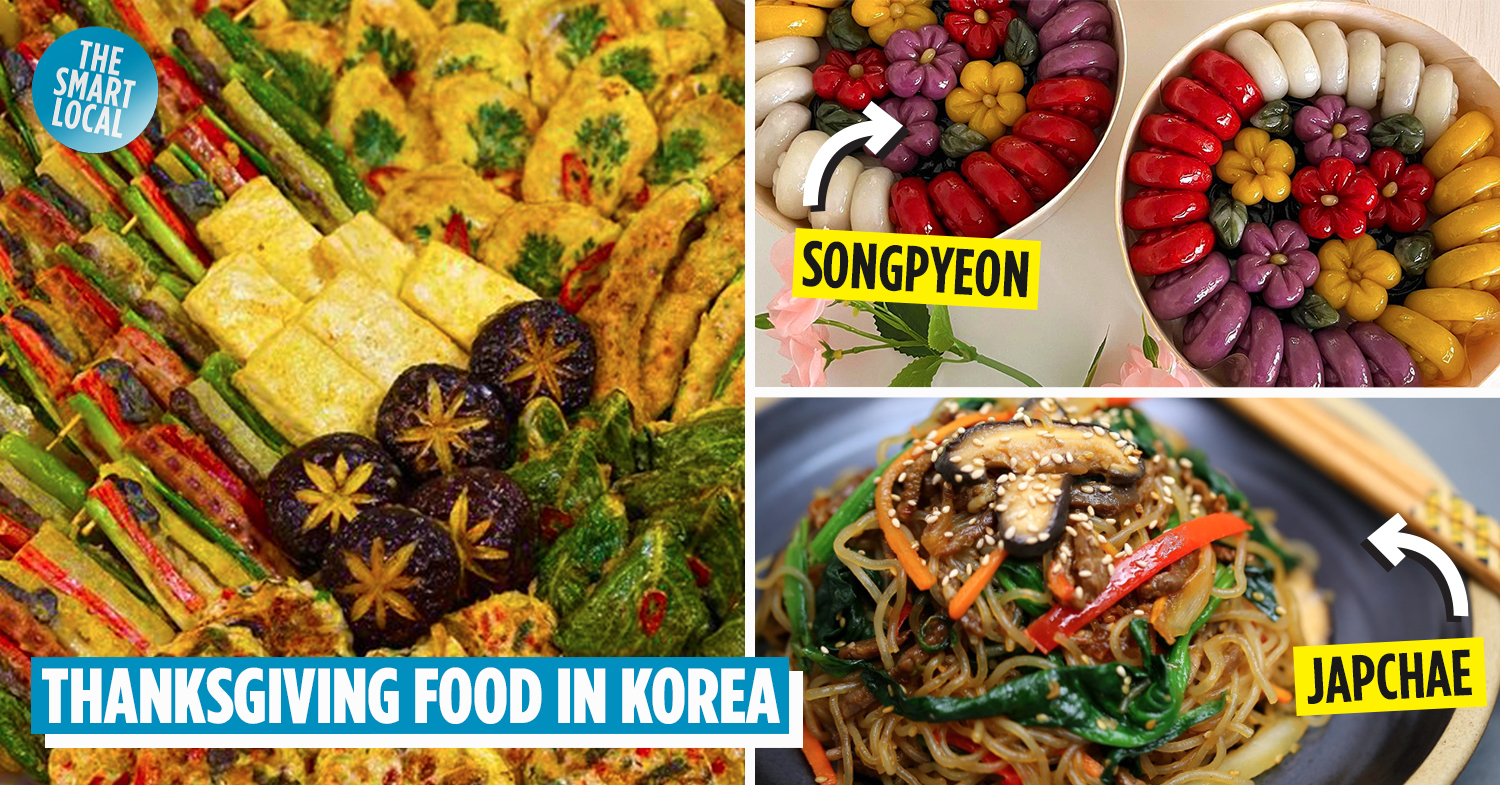Chuseok food eaten during Korean Thanksgiving
To Koreans, autumn heralds the arrival of Chuseok. Also known as the Korean Thanksgiving, Chuseok is a time when families gather to pay respects to the deceased and feast on various Chuseok foods. While this may vary by region, we’ve compiled a list of common Chuseok food recipes for you to try out.
1. Songpyeon 송편
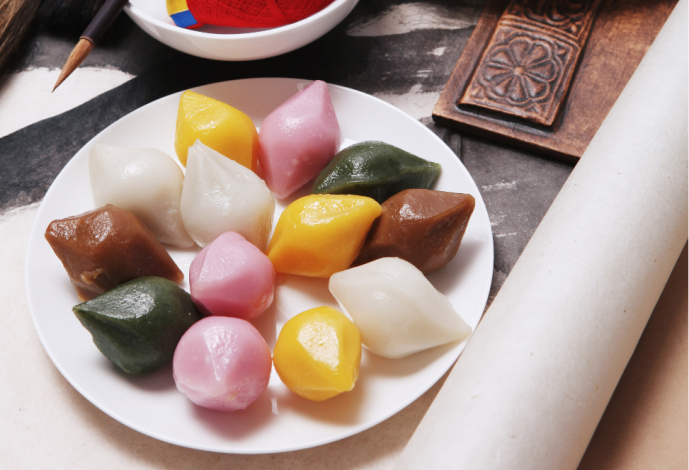
Image credit: Donga Science
Chuseok wouldn’t be the same without songpyeon (pine cakes). These are small rice cakes that are traditionally steamed on pine needles. They are shaped like crescents, which symbolises future prosperity, and come in vibrant colors such as pink, orange, and green. Songpyeon is usually served for dessert as they contain sweet fillings like red beans or brown sugar.
Ingredients:
- Rice powder
- Boiling water
- Roasted sesame seeds
- Honey
- Salt
- Sesame oil
- Pine needles
- Mashed kabocha squash (for orange dough) or matcha powder (for green dough)
Steps:
- Grind sesame seeds until half-ground.
- Mix the sesame seed mixture with some honey and a bit of salt.
- Set this aside to be used as filling.
- Add 4 tbsps of boiling water to 2 cups of rice powder. If you are making coloured dough, add your mashed kabocha squash or matcha powder to the mixture as well.
- Leave to cool for a bit. Once it has cooled, knead for approximately 5 minutes to form your dough.
- Make small balls of dough and then flatten them out with your fingers.
- Scoop a bit of the sesame seed filling onto the flattened out dough.
- Fold the dough with its filling into a half-moon shape and then place aside for steaming. Repeat until dough and filling mixtures are used up.
- Line your steamer with pine needles and place the uncooked songpyeon into it. Steam for about 10-15 minutes.
- Once cooked, rinse in a bowl of cold water to remove any stuck pine needles.
- Coat the cooked songpyeon with sesame oil evenly and serve.
2. Pajeon 파전
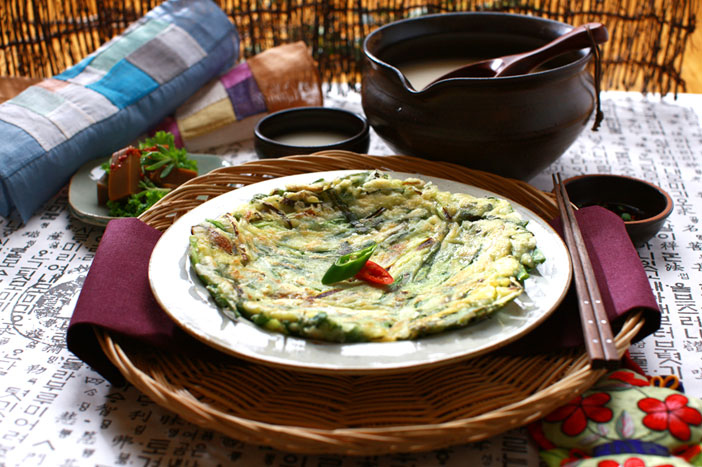
Image credit: VisitKorea
While commonly referred to as Korean scallion pancake, the word “pajeon” actually comes from “pa”, meaning “scallions”, and “jeon”, which refers to “food that is pan-fried in batter”.
Although there are different types of pajeon, such as the haemul pajeon (seafood scallion pancake), the plain version is traditionally served at Chuseok. It is best eaten with a simple dipping sauce made of soy sauce, vinegar, and toasted sesame seeds.
Ingredients:
- Scallions
- Eggs
- Korean pancake mix (buchim garu, 부침가루)
- Vegetable oil
- Soy sauce
- Vinegar
- Sesame seeds
Steps:
- Cut the scallion into 5cm pieces. Slice the white parts into half vertically so that they can cook evenly.
- Coat the sliced scallions with 1 tbsp of pancake mix.
- Beat the eggs.
- Add ice cold water and the coated scallions to the pancake mix to form your batter.
- Heat your frying pan up to medium heat and coat with vegetable oil.
- Pour the batter with scallions onto the pan and spread it out.
- Pour the beaten eggs evenly over the top.
- Lower the heat after about 1 minute and check if the rim of the pancake has turned crispy.
- After another 3 to 4 minutes, check if the bottom of the pancake has cooked and flip the pancake to cook the other side.
- Cook for another 3 to 4 minutes until golden brown.
- Serve with a mixture of soy sauce, vinegar and sesame seeds as dipping sauce.
3. Perilla leaf jeon 깻잎전
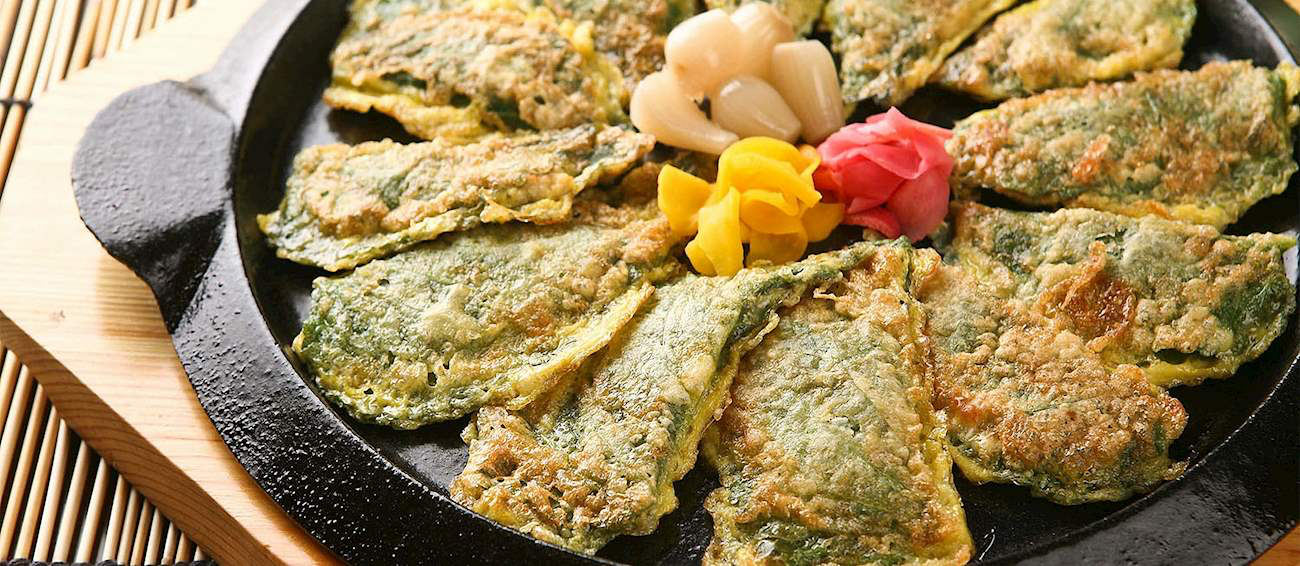
Image credit: tasteatlas
Perilla leaf jeon consists of meat filling wrapped in a perilla leaf that is folded into half, and then dipped into a seasoned egg batter before pan frying.
Perilla leaves are a type of herb that is commonly eaten with meat at places like Korean barbeque restaurants. Its minty taste helps balance the greasiness of barbequed meat.
Ingredients:
- Perilla leaves
- Minced meat (beef or pork)
- Minced garlic
- Chopped scallions
- Soy sauce
- Ground black pepper
- Sesame oil
- Eggs
- Flour
- Vegetable oil
- Vinegar
- Sesame seeds
Steps:
- Wash and strain perilla leaves well. Leave to dry.
- Combine minced meat, minced garlic, chopped scallions, soy sauce, ground black pepper, and sesame oil in a bowl. Mix well to form your meat filling and set aside.
- Beat eggs and set aside.
- Coat both sides of the dried perilla leaves with flour.
- Add the meat mixture onto the centre of the leaves and fold into half.
- Heat your frying pan up to medium heat and coat with vegetable oil.
- Dip the perilla leaves with meat mixture into the beaten egg so that it’s fully coated.
- Place the egg-coated leaves with meat mixture onto the frying pan and make sure that they’re spaced apart evenly.
- Cook for about 2 minutes until one side turns crispy. Flip and cook the other side.
- Serve with a mixture of soy sauce, vinegar, and sesame seeds as dipping sauce.
4. Wanjajeon 완자전
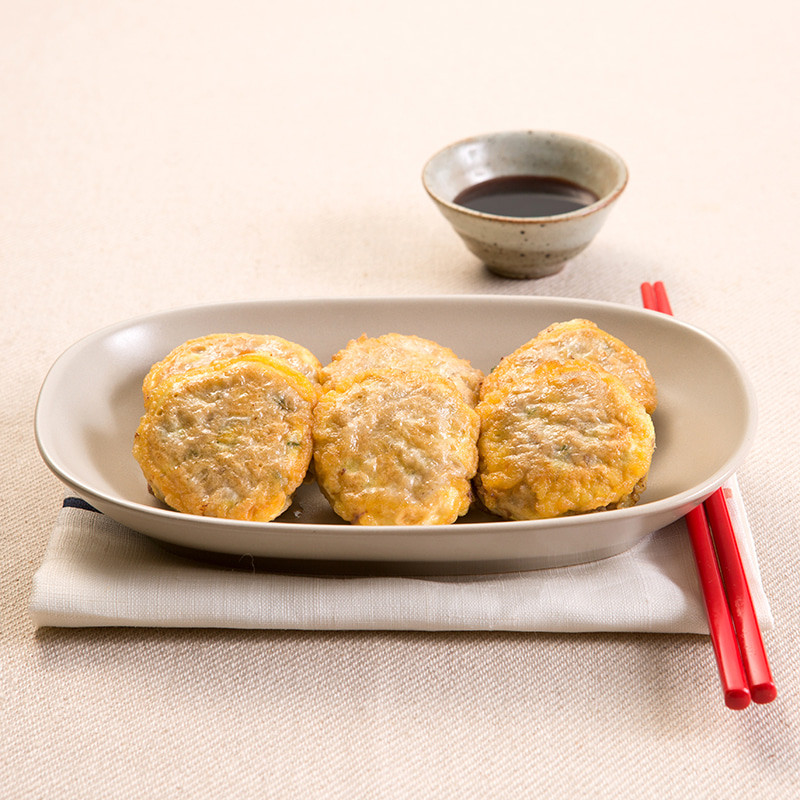
Image credit: Young313
Wanjajeon are mini meat patties – made of beef, pork, or both – that are dipped into egg batter and then pan fried. Koreans often call these “dong-geu-rang-ttaeng” (동그랑땡) – which roughly translates to “circle coin” – due to its small and round appearance.
While wanjajeon was customarily only eaten during festive seasons like Chuseok, it is commonly included in everyday lunch boxes nowadays.
Ingredients:
- Minced meat (beef, pork, or both)
- Tofu
- Chopped onion
- Chopped carrot
- Chopped scallions
- Eggs
- Plain flour
- Vegetable oil
- Soy sauce
- Vinegar
- Sesame seeds
Steps:
- Mash the tofu to remove moisture as much as possible.
- Add the chopped onion, carrot and scallions to the mashed tofu.
- Dry the minced meat using paper towels and add it to the mixture above.
- Add salt, pepper and plain flour to the mixture.
- Mix everything together thoroughly.
- Make small meat patties about the size of a large coin using the mixture.
- Coat the patties with plain flour.
- Beat the eggs.
- Heat your frying pan up to medium heat and coat with vegetable oil.
- Dip the patties into the beaten egg such that it’s fully covered.
- Place the egg-coated leaves with meat mixture onto the frying pan and make sure that they’re spaced apart evenly.
- Cook for about 2 minutes until one side turns crispy. Flip and cook the other side.
- Serve with a mixture of soy sauce, vinegar and sesame seeds as dipping sauce.
5. Galbijjim 갈비찜
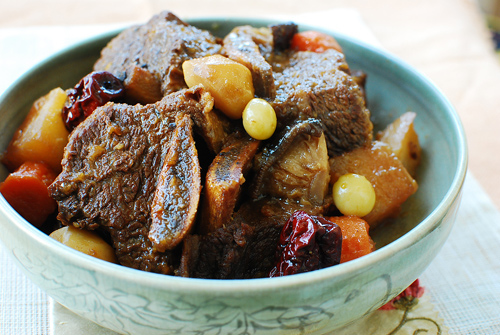
Image credit: Trends Recipes
Galbijjim refers to Korean braised short ribs. It is often made with beef short ribs, although pork ribs work just as well. While it was once regarded as a dish eaten only by the wealthy, today, galbijjim can be eaten during festive holidays or special occasions such as birthdays and weddings.
Ingredients:
- Soy sauce
- Sugar
- Rice wine
- Water
- Minced garlic
- Minced ginger
- Sesame oil
- Pepper
- Short ribs
- Oyster or shiitake mushrooms
- Radish
- Carrot
- Scallions
Steps:
- Soak short ribs in cold water overnight to drain the blood.
- Mix soy sauce, sugar, rice wine, minced garlic, minced ginger, sesame oil, and pepper to make the sauce.
- Cut the mushrooms, radish and scallion up into small pieces. Slice the carrot into thin pieces as well.
- Rinse the drained meat clean with water.
- Place the short ribs, the sauce, 1L of water into a pot.
- Bring the mixture to a boil and then lower the heat to medium. Leave it for 1 hour.
- After an hour, add radishes to cook.
- When the radishes are half done, add the carrots, mushrooms and scallions. Leave to simmer.
- Mix well and serve.
6. Tri-coloured namul 삼색나물
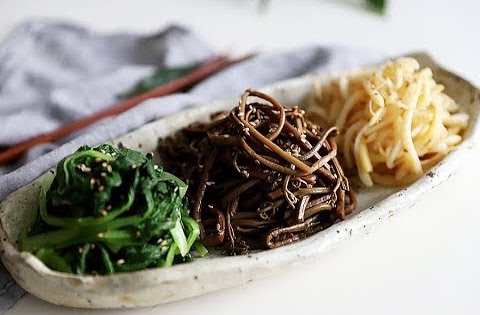
Image credit: 햇살한스푼
Namul refers to seasoned vegetables that are eaten as banchan (side dishes) with regular meals. These serve to balance out the heavier dishes eaten during Chuseok.
Tri-coloured namul is made of different types of seasoned veggies in 3 colours – green, black or brown, and white. The most traditional combination consists of sigeumchi namul (seasoned spinach), doraji namul (seasoned Korean bellflower roots), and gosari namul (seasoned Korean bracken/fernbrake).
Ingredients:
- Spinach
- Dried doraji (Korean bellflower roots)
- Dried gosari (Korean bracken)
- Sea salt
- Sesame seeds
- Minced garlic
- Sesame oil
- Vegetable oil
- Soy sauce
- Chopped green onions
Steps:
- Soak the dried doraji and gosari overnight in water.
- Wash the spinach and blanch it in boiling water for about 30 seconds. Drain after and squeeze out as much water as possible.
- Blanch the gosari in boiling water for a few minutes to soften them. Drain after.
- Sort through the gosari stems and break off those that are too tough.
- Cut the doraji and gosari into strips.
- Mix the spinach with sesame oil, minced garlic and sea salt.
- Saute the doraji with minced garlic in vegetable oil. Sprinkle sesame oil and chopped green onions to garnish.
- Saute the gosari with minced garlic and soy sauce in vegetable oil. Sprinkle sesame oil and chopped green onions to garnish.
- Plate together as tri-coloured namul and serve.
Check out Korean celebrity chef Paik’s videos on sigeumchi namul, doraji namul, and gosari namul for more detailed instructions.
7. Japchae 잡채
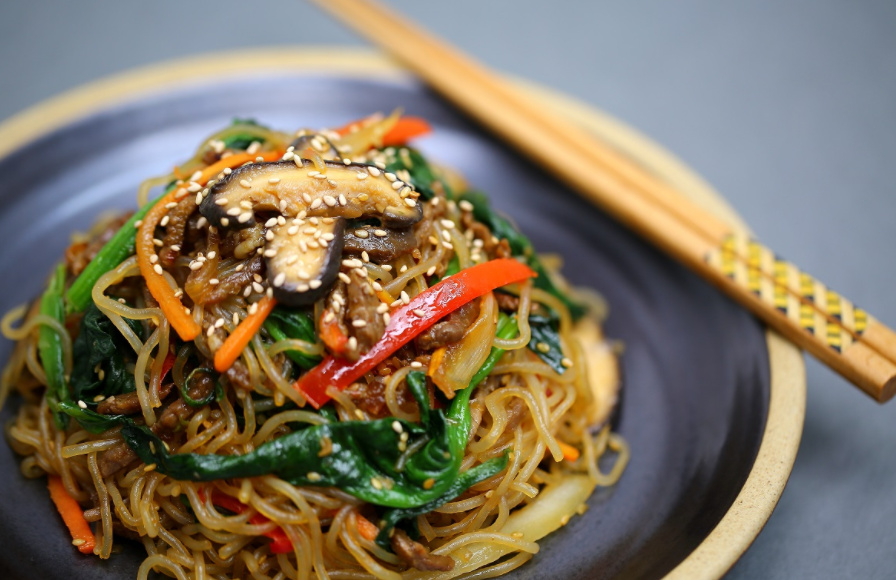
Image credit: ZENITH GLOBAL
Although japchae literally translates to “mixed vegetables”, the dish actually comprises Korean glass noodles stir-fried with sliced vegetables, mushrooms, and sesame seeds. It can be served as an appetiser by itself or as a side dish with rice.
Ingredients:
- Dangmyeon noodles (Sweet potato starch noodles)
- Carrot
- Onion
- Sesame oil
- Salt
- Shiitake mushrooms
- Spinach
- Minced garlic
- Honey
- Sesame seeds
Steps:
- Boil the dangmyeon noodles for about 8 minutes and drain the excess water. Set aside.
- Cut the carrot up into strips.
- Slice the onion and shiitake mushrooms up.
- Blanch the spinach. Drain and squeeze out the excess water after.
- Stir fry the carrot, onion, mushrooms and spinach individually with sesame oil and some salt. Set each one aside.
- Mix cooked noodles with soy sauce, sesame oil, and honey in a large mixing bowl.
- Add the cooked vegetables into the noodles and mix as well.
- Garnish with sesame seeds and serve.
8. Toran guk 토란국
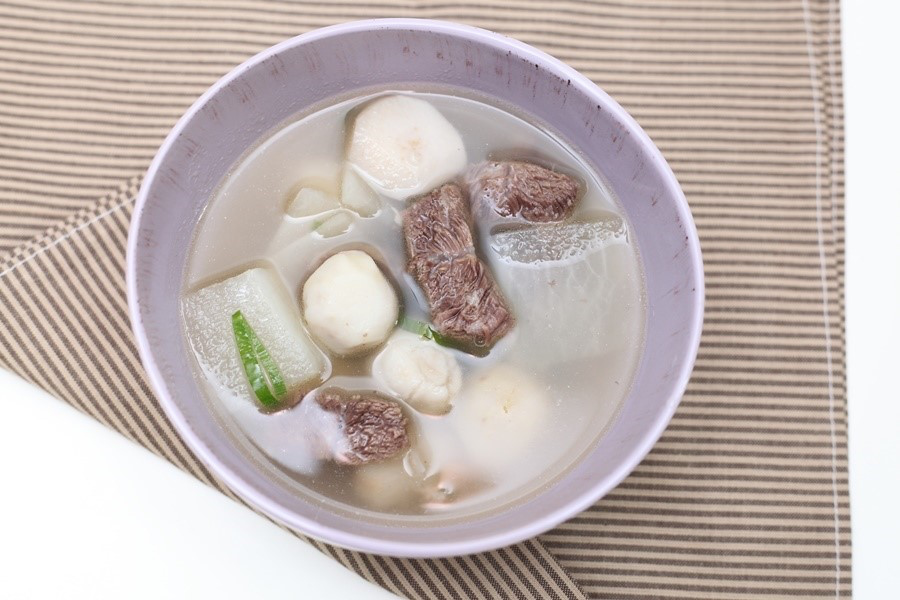
Image credit: 예쁜포비
Toran guk is a clear soup that contains beef brisket and taro, the latter of which imparts a slightly nutty and earthy flavour. This is traditionally eaten during Chuseok as taro’s peak season is in fall.
Ingredients:
- Taro
- Beef brisket
- Chopped scallions
- Minced garlic
- Fish sauce
- Salt
- Perilla seeds powder
Steps:
- Boil the taro and peel it. Rinse the peeled taro and slice it.
- Boil a pot of water over medium heat.
- When the water reaches a boil, add the garlic and beef brisket. Cover and cook for 10 minutes.
- Add the peeled taro, salt, and fish sauce to the pot. Cover and cook for 20 minutes.
- Use a fine strainer to soak some perilla seed powder into the soup until it turns milky. Remove the sludge in the strainer after.
- Add the chopped scallions and cook for another 1 to 2 minutes.
- Serve with rice.
9. Sujeonggwa 수정과
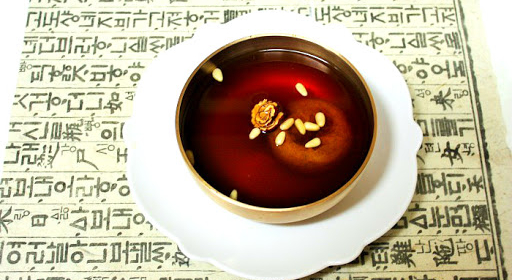
Image adapted from: Menupan 키친
Sujeonggwa, or Korean cinnamon punch, is a popular traditional dessert beverage drunk during the holiday season. It is good to serve after a hearty meal as it helps with digestion.
The main ingredients include cinnamon, ginger, and sugar. Many Koreans add a slice of dried persimmon and pine nuts at the end for garnish.
Ingredients:
- Cinnamon sticks
- Sliced fresh ginger
- Brown sugar
- Dried persimmon
- Pine nuts
Steps:
- Add sliced ginger to a pot with 5 cups of water. Bring to a boil and simmer for 20 minutes.
- Add cinnamon sticks to another pot with 5 cups of water. Bring to a boil and simmer for 20 minutes.
- Remove the sliced ginger and cinnamon sticks from the infused water.
- In a bigger pot, combine the ginger water and cinnamon water. Add half a cup of sugar.
- Bring to a boil and simmer for 2 to 3 minutes.
- Cool before serving with dried persimmons and pine nuts for garnish.
10. Sikhye 식혜
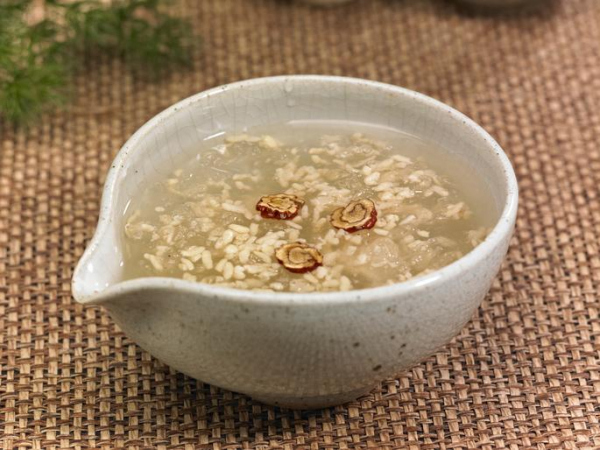
Image credit: Medical Report
Usually served after a meal as a dessert, sikhye is a slightly sweetened traditional Korean drink made from malted barley and cooked rice. The drink is so beloved by Koreans that they’ve made it into a canned beverage as well.
Ingredients:
- Malted barley flour
- Steamed white rice
- Sugar
- Pine nuts
Steps:
- Add the malted barley flour into tea bags.
- Place the tea bags containing malted barley flour into a rice cooker pot. Add water and cooked rice.
- Set the rice cooker to warm. Leave it for about 4 to 8 hours. The mixture is ready once there are about 20 grains floating at the top.
- Remove the tea bags containing malted barley flour.
- Strain the rice and leave it in another container for later. Add some water into this container.
- Pour the rest of the liquid into a large pot and add sugar. Boil at high heat until sugar dissolves.
- Leave the drink to cool. Serve with some of the rice from step 5 and pine nuts as garnish.
Bonus: Korean Pears
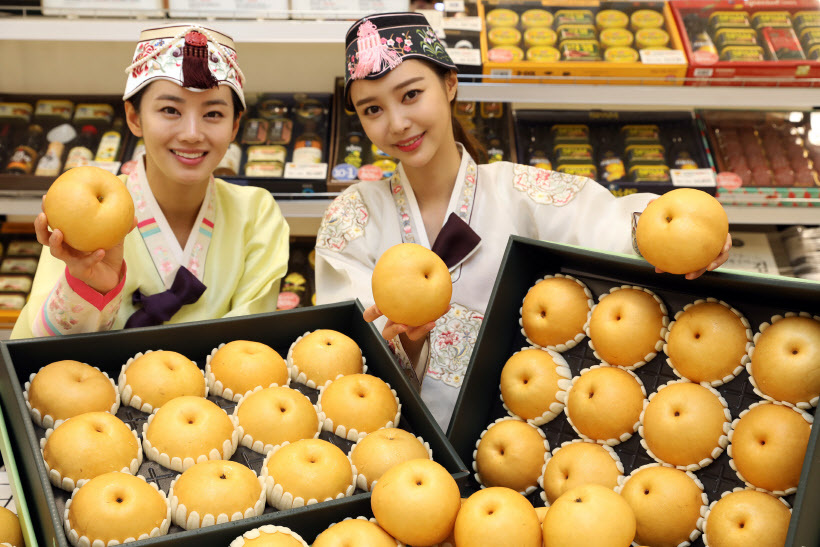
Image credit: 뉴데일리 경제
Because Chuseok was traditionally celebrated as a harvest festival in the past, fruits were commonly eaten during the holiday season. In particular, Korean pears, or bae, are representative of the season. Unlike green pears, bae are spherical in shape. They are highly prized for their crunchy texture and juiciness, which make them the perfect addition to Chuseok gift sets.
Easy Chuseok food recipes
As Korea’s most important holiday, Chuseok is a time when families gather together to celebrate and feast. While there are numerous other dishes served during this time, these chuseok food recipes are a good starting point to understanding the holiday better.
Read more about Korean food and culture here:
- Regional soju brands
- Traditional Korean snacks
- Korean YouTube cooking channels
- Modern hanboks
- Korean web dramas
Cover image adapted from (clockwise from left): @_rosekyung, @this_very_day_ and ZENITH GLOBAL
